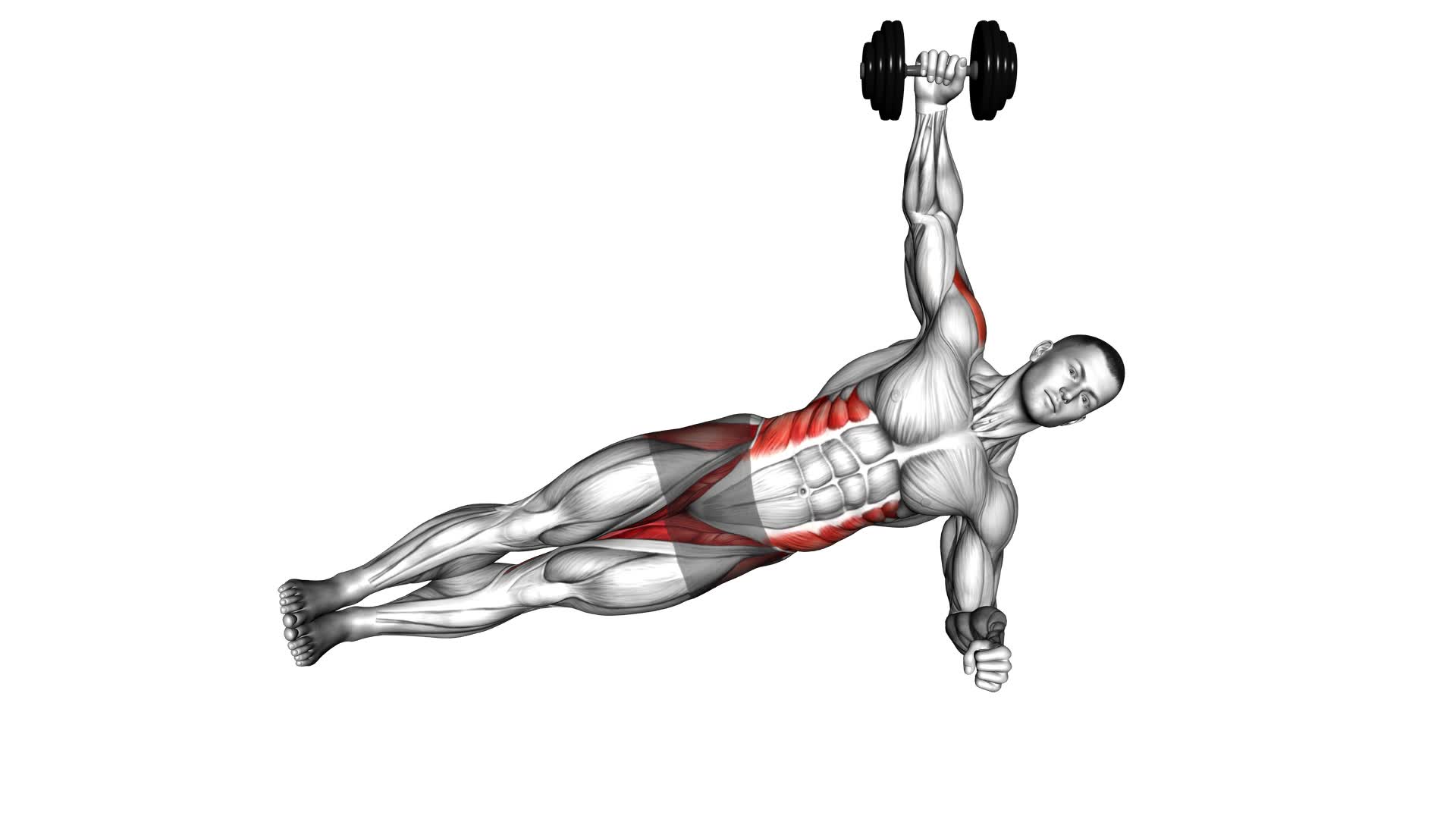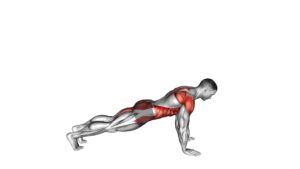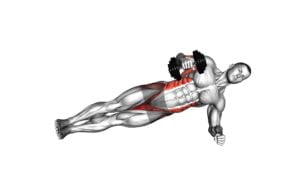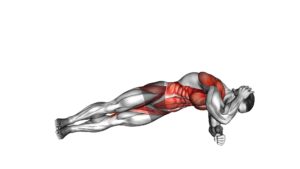Dumbbell Side Plank Raise (male) – Video Exercise Guide & Tips

Get ready to sculpt your core and build serious strength with the dumbbell side plank raise. In this exercise, you'll target your obliques, shoulders, and overall stability.
Watch This Exercise Video
By adding weight to the classic side plank, you'll take your workout to the next level.
Watch the video guide, learn the proper technique, and discover tips to avoid common mistakes.
With this exercise in your routine, you'll maximize your results and take your fitness journey to new heights.
Key Takeaways
- The Dumbbell Side Plank Raise targets obliques, hip muscles, and shoulders.
- Proper technique and form involve engaging the core, lifting the hips off the ground, and using oblique muscles to lift the dumbbell.
- It is important to choose a dumbbell weight that challenges the muscles without compromising form to avoid injury.
- Gradually increasing weight and incorporating variations can maximize results and continue progress.
Benefits of the Dumbbell Side Plank Raise
You can experience significant core strength gains by incorporating dumbbell side plank raises into your workout routine. This exercise targets your obliques, hip muscles, and shoulders, helping to improve core stability engagement. Dumbbell side plank raise variations allow you to challenge different muscle groups and increase the difficulty as you progress.
By adding dumbbells to your side plank raises, you increase the resistance and intensity of the exercise. This leads to greater muscle recruitment and promotes muscle growth and strength development. The added weight also helps improve shoulder stability and strengthens the muscles surrounding the joint.
One variation of the dumbbell side plank raise is the lateral raise. In this variation, you hold a dumbbell in your top hand and raise it towards the ceiling while maintaining the side plank position. This targets the shoulder muscles, enhancing upper body strength and stability.
Another variation is the front raise, where you hold a dumbbell in your top hand and raise it in front of you while maintaining the side plank position. This variation primarily targets the anterior deltoids and improves shoulder strength and stability.
Incorporating dumbbell side plank raise variations into your workout routine not only enhances core strength but also improves overall stability and shoulder strength. Now, let's move on to the next section and discuss the proper technique for the dumbbell side plank raise.
Proper Technique for the Dumbbell Side Plank Raise
To perform the dumbbell side plank raise correctly, start by lying on your side with a dumbbell in your top hand. Begin by positioning your feet together and your forearm on the ground, directly beneath your shoulder. Engage your core and lift your hips off the ground, forming a straight line from your head to your feet. Keep your body stable throughout the exercise.
With the dumbbell in your top hand, lift it upwards while maintaining control and stability. As you raise the dumbbell, focus on using your oblique muscles to initiate the movement. Keep your arm straight and your wrist neutral as you lift the weight.
It's important to maintain proper technique during the dumbbell side plank raise to ensure effective muscle activation. By engaging your oblique muscles and avoiding excessive movement or rotation, you can maximize the benefits of this exercise. The primary muscles targeted during this exercise are the obliques, which are located on the sides of your abdomen.
Incorporating the dumbbell side plank raise into your workout routine can help strengthen your core, improve stability, and enhance overall functional fitness. Remember to start with a weight that challenges you but allows you to maintain proper form. As with any exercise, if you experience any pain or discomfort, it's best to consult with a fitness professional.
Recommended Dumbbell Weight for Men
When determining the recommended dumbbell weight for men, there are a few key points to consider.
First, it's important to choose a weight that challenges your muscles without compromising your form. This will help promote muscle growth and increase strength over time.
Additionally, it's crucial to avoid using weights that are too heavy, as this can increase the risk of injury.
Optimal Weight for Men
Selecting the appropriate dumbbell weight for men requires considering factors such as strength level and exercise goals. To determine the optimal weight for your workouts, keep the following in mind:
- Muscle growth: If your goal is to build muscle, choose a weight that allows you to perform 8-12 repetitions with proper form. This weight should challenge you but not be too heavy to compromise technique.
- Weightlifting techniques: Different weightlifting techniques require different weights. For compound exercises like squats and deadlifts, opt for heavier dumbbells to stimulate multiple muscle groups. For isolation exercises like bicep curls, lighter dumbbells are sufficient for targeting specific muscles.
- Progression: As you become stronger and more comfortable with a certain weight, gradually increase the dumbbell weight to continue challenging your muscles and promoting progress.
Muscle Building Recommendations
If you want to build muscle, it's important to choose the right dumbbell weight that challenges you without compromising your form. When it comes to muscle building techniques, using the appropriate weight is crucial for optimal results. The recommended dumbbell weight for men varies depending on your current fitness level and strength. Generally, it's advised to start with a weight that allows you to perform 8-12 repetitions with proper form.
As you progress and become stronger, you can gradually increase the weight to continue challenging your muscles. Alongside the right weight, nutrition plays a vital role in muscle growth. Make sure to consume enough protein to support muscle repair and growth, and maintain a well-balanced diet to provide your body with the necessary nutrients.
Avoiding Injury With Weights
To prevent injury while working with weights, it's crucial that you choose the appropriate dumbbell weight that challenges you without compromising your form. Here are three important tips to help you avoid injury and ensure weightlifting safety:
- Start with a weight that allows you to perform the exercise with proper technique. This will help you develop the necessary strength and stability before progressing to heavier weights.
- Gradually increase the weight as you become more comfortable and confident with your form. Remember, it's better to start light and progress slowly than to risk injury by lifting too heavy too soon.
- Always listen to your body and prioritize safety over ego. If you feel any pain or discomfort, lower the weight or stop the exercise altogether. Pushing through pain can lead to serious injuries.
Common Mistakes to Avoid
To perform the dumbbell side plank raise correctly and avoid common mistakes, it's crucial to pay attention to your elbow positioning. Keep your elbow directly beneath your shoulder to maintain proper alignment and prevent strain on your joints.
Additionally, engaging your core throughout the exercise is essential for stability and to ensure that you're targeting the correct muscles effectively.
Elbow Positioning Importance
Make sure you maintain proper elbow positioning to avoid common mistakes during the dumbbell side plank raise exercise. The importance of form can't be overstated when performing this exercise. Keeping your elbows directly under your shoulders helps to ensure proper alignment of your body, maximizing the benefits of stability.
Here are three key tips to help you maintain proper elbow positioning:
- Position your elbows directly under your shoulders.
- Keep your elbows slightly bent to avoid hyperextension.
- Engage your core muscles to stabilize your body throughout the exercise.
By maintaining proper elbow positioning, you not only reduce the risk of injury but also enhance the effectiveness of the dumbbell side plank raise.
Now let's move on to the next section and discuss how to engage your core for stability.
Engage Core for Stability
To ensure stability during the dumbbell side plank raise, you should engage your core muscles and avoid common mistakes.
Core stability is crucial for maintaining balance and control throughout the exercise. Engaging your core means activating the muscles in your abdomen, lower back, and pelvis to provide a solid foundation of support. This will help you maintain proper alignment and prevent any unnecessary movement or swaying during the exercise.
Common mistakes to avoid include letting your hips sag or rotate, as this can put strain on your lower back and compromise your stability. Additionally, make sure to breathe properly and maintain a neutral spine throughout the exercise to maximize core engagement and minimize the risk of injury.
Tips to Maximize Your Results
To maximize your results with the dumbbell side plank raise, focus on maintaining proper form and gradually increasing the weight of the dumbbell. Here are some tips to help you maximize the effectiveness of this exercise and make modifications to suit your workout needs:
- Engage your core: Keep your core muscles engaged throughout the exercise to maximize the effectiveness of the side plank raise. This will help stabilize your body and target the muscles more effectively.
- Start with lighter weights: If you're new to this exercise, start with lighter weights to perfect your form and build strength gradually. It's important to focus on proper technique before increasing the weight.
- Progressively increase weight: As you become more comfortable with the exercise, gradually increase the weight of the dumbbell. This will challenge your muscles and help you see better results over time.
Variations and Progressions for Advanced Trainees
To challenge yourself further and continue progressing as an advanced trainee, explore different variations and progressions of the dumbbell side plank raise exercise.
These variations and progressions will help you target different muscle groups and increase the intensity of the exercise.
One variation you can try is the weighted side plank raise, where you hold a dumbbell in your top hand while performing the exercise. This adds resistance and increases the challenge for your core and shoulder muscles.
Another variation is the side plank with leg lift, where you lift your top leg while holding the side plank position. This targets your glutes and hip abductors in addition to your core.
To further progress, you can try the dynamic side plank raise, where you perform a full side plank raise and then lower your body back down in a controlled manner. This challenges your stability and control throughout the movement.
These advanced techniques will help you continue to build strength and improve your overall fitness level. Remember to always maintain proper form and gradually increase the difficulty as you become more comfortable with each variation.
Frequently Asked Questions
How Many Repetitions Should I Do for the Dumbbell Side Plank Raise?
For the dumbbell side plank raise, the number of repetitions you should do may vary depending on your fitness level and goals. It's generally recommended to start with 8-12 repetitions per side and gradually increase as you get stronger.
If you find it too challenging, you can modify the exercise by using a lighter weight or performing the exercise without any dumbbells.
Remember to listen to your body and adjust accordingly to avoid injury.
Can Women Also Perform the Dumbbell Side Plank Raise Exercise?
Yes, men and women can both benefit from the dumbbell side plank raise exercise.
This exercise targets the core muscles, shoulders, and hips, helping to improve stability and strength.
By incorporating dumbbells, you can further challenge your muscles and increase the intensity of the exercise.
Whether you're a man or a woman, adding dumbbell side plank raises to your workout routine can be an effective way to strengthen your body and improve overall fitness.
Is It Necessary to Use Dumbbells for the Side Plank Raise, or Can I Use Other Equipment?
You don't necessarily have to use dumbbells for the side plank raise. There are alternatives to using dumbbells such as resistance bands, kettlebells, or even just bodyweight.
These alternatives can still provide benefits and help you engage your muscles effectively during the exercise. Using different equipment for the side plank raise can add variety to your workout routine and challenge your muscles in different ways.
How Long Should I Hold the Side Plank Position During the Exercise?
To progress in the side plank exercise, focus on increasing your hold time gradually. Start with holding the position for 10-15 seconds and gradually work your way up to 30 seconds or more.
This will help strengthen your core and improve stability. Be mindful of common mistakes such as letting your hips sink or lifting them too high.
Maintain proper alignment and engage your core throughout the exercise for maximum effectiveness.
Can the Dumbbell Side Plank Raise Help in Reducing Love Handles or Belly Fat?
The dumbbell side plank raise is a beneficial exercise that can help in reducing love handles and belly fat. It targets the oblique muscles, which are responsible for toning and slimming the waistline.
While this exercise alone may not be enough to spot-reduce fat in these areas, it can definitely contribute to an overall reduction in body fat when combined with a balanced diet and other full-body exercises.
Incorporating this exercise into your routine is a great way to work towards your fitness goals.
Conclusion
In conclusion, the dumbbell side plank raise is a highly effective exercise for men that targets the core and shoulders.
By following the proper technique and using the recommended dumbbell weight, you can maximize your results and avoid common mistakes.
Additionally, incorporating variations and progressions can challenge advanced trainees.
Overall, this exercise is a valuable addition to any workout routine for men looking to strengthen their core and build upper body strength.

Author
Years ago, the spark of my life’s passion ignited in my mind the moment I stepped into the local gym for the first time. The inaugural bead of perspiration, the initial endeavor, the very first surge of endorphins, and a sense of pride that washed over me post-workout marked the beginning of my deep-seated interest in strength sports, fitness, and sports nutrition. This very curiosity blossomed rapidly into a profound fascination, propelling me to earn a Master’s degree in Physical Education from the Academy of Physical Education in Krakow, followed by a Sports Manager diploma from the Jagiellonian University. My journey of growth led me to gain more specialized qualifications, such as being a certified personal trainer with a focus on sports dietetics, a lifeguard, and an instructor for wellness and corrective gymnastics. Theoretical knowledge paired seamlessly with practical experience, reinforcing my belief that the transformation of individuals under my guidance was also a reflection of my personal growth. This belief holds true even today. Each day, I strive to push the boundaries and explore new realms. These realms gently elevate me to greater heights. The unique combination of passion for my field and the continuous quest for growth fuels my drive to break new ground.







